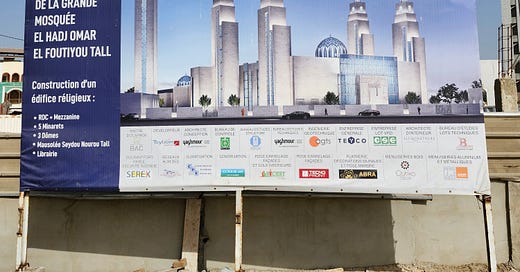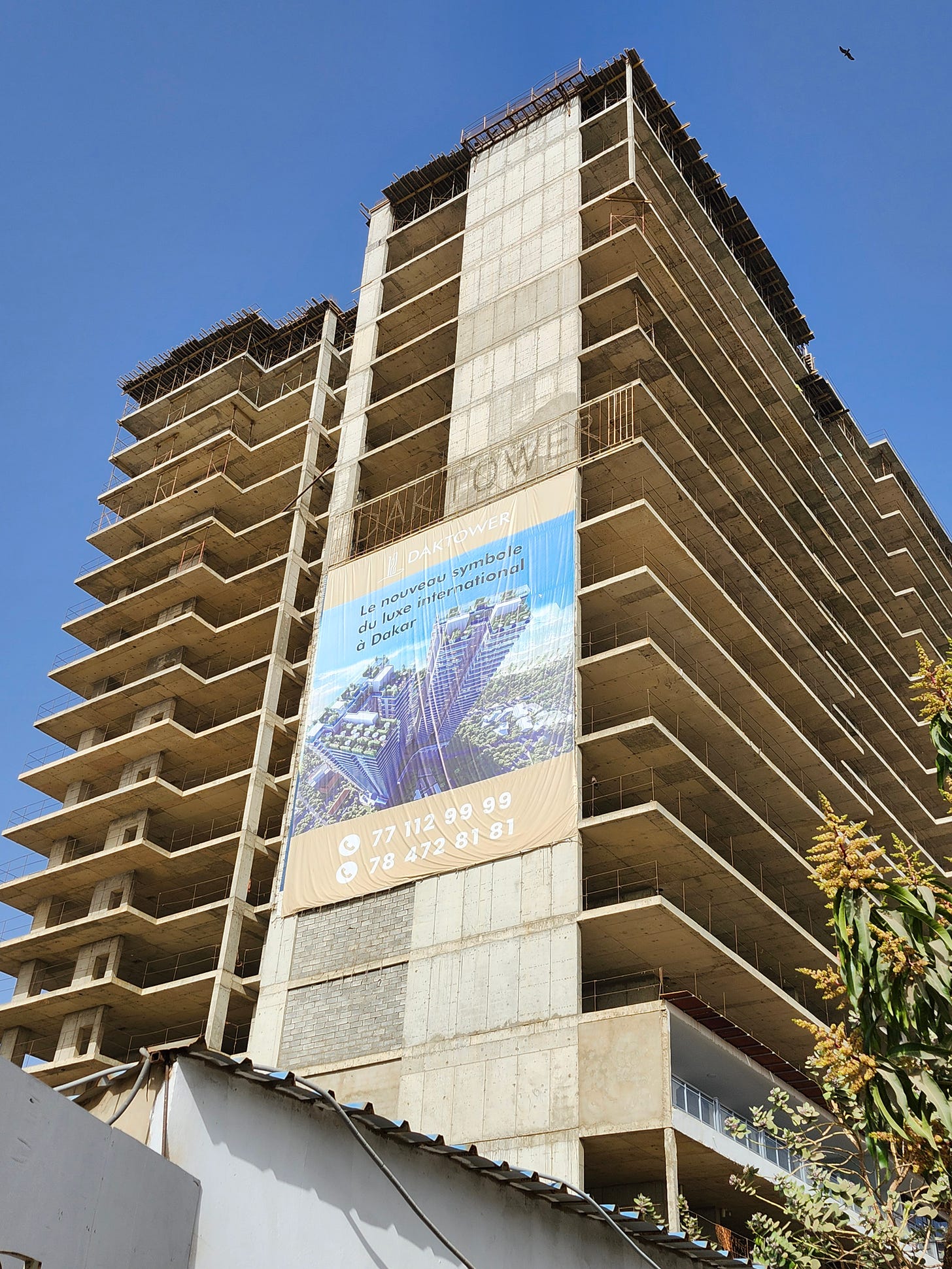Travel Notes - Senegal (Dakar), February 2025
Luxury developments and everyday life in a West African capital.
I spent the first week of February in Dakar, Senegal’s capital, where I hadn’t been since 2019. I was there as part of a broader research project of mine about the trajectory of Islamic law in northwest Africa, but I’ll leave that aside for the moment. Here I’ll just share some of my casual observations from walking/riding around the city.
I covered a lot of ground on foot, including much of the highlighted portion here, and I went by cab to a few different areas further north.
Here are two main themes that struck me:
The Construction Boom
A lot has been written and reported about the property/construction boom in Dakar, a boom that began well before current President Diomaye Faye took office in April 2024. Here is one brief video report on the boom from France24.
Seeing all the construction in person really made an impression. At times it seemed that I saw a new building going up on every block. These were active work zones, too, even on a Saturday. And every worker I saw appeared to be Senegalese. [Edit: a well-informed reader wrote to tell me that many of the workers are Guinean.]
Which firms are doing the building? Answering that would be a major research project in and of itself, but one photograph I took - of a mega-mosque project - highlights a swath of companies involved in this one project alone.
Riding down Aliou Ardo Sow Boulevard (so renamed in 2022 by decree of then-President Macky Sall) a day or so later, I connected a few dots; Sow, a Senegalese billionaire, died in 2017 after his Compagnie Sahélienne d'Entreprises had spent 47 years building public works. His son Yérim Habib Sow owns Teyliom, a mega-company of which Teyco is the construction wing. It would be truly fascinating to map all the players in the sector.
Meanwhile the construction boom offers and cultivates a certain image of Dakar - namely, a promise of luxury.
My skills as a photographer are not so good, but you might be able to make out the text - in translation, “The New Symbol of International Luxury in Dakar.” This is Dak Tower, whose website proclaims, “The prestige of Central Park and the luxury of Dubai, now in the heart of Dakar.” Downtown Dakar is - at least in developers’ visions - being reinvented as a zone of high rise towers and as a cosmopolis linked to and comparable to other fast-paced global cities.
A Mixed Economic Picture
Who is the development for? And how are most residents of Dakar doing? Here are a few quick and therefore inevitably superficial and anecdotal data points. First, during my time living in Senegal in 2006-2007, my dad came to visit me and noticed that every single taxi we rode in had a cracked windshield; in 2025, I didn’t see a single crack, and there were many new cars on the road. Second, there seemed to be both more businesses and more kinds of businesses than there were nearly twenty (!) years ago. Senegal’s GDP has, after all, tripled since 2006, so it makes sense that the effects of that growth would be quite visible. Also, it seems a good part of the money spent on construction is flowing into the national economy.
Third, however, the sprawling informal economy still appeared to be the key source of income for many people; amid the sound of jackhammers and the shouts of construction workers, there were many people selling clothes or street food or running small stands. GDP per capita, for the sake of comparison, has not quite doubled since 2006. Senegal is classed as “lower-middle income” by the World Bank, as are most other West African coastal countries, and Senegal is doing markedly better than the landlocked Sahelian countries nearby. The informal economy, meanwhile, is not always a poverty trap - an American acquaintance, a journalist, was telling me that a fruit vendor with the right connections and savvy can transform a stand into a store into a network. I believe it.
Yet there is still substantial poverty and the “prestige of Central Park” is on offer for only a select few; one also wonders whether the target audience of Dak Tower and other such project is mostly foreigners. And the development/construction boom appears (to this non-economist!) to be intensifying some already serious, long-term pressure on ordinary residents. President Faye has called attention to the crisis of high rents in Dakar, and has experimented with price controls on staple goods.
I did not have occasion to go into the outer suburbs, where the poverty is even more acute; in writing this post, I found this interesting study. The authors argue that projects to improve transportation within Dakar, for example a rapid bus system, nevertheless price out the poor, leaving them even more dependent on walking to meet their needs. (Sidewalk infrastructure is quite inconsistent, even downtown.)
Ultimately, amid this story of inequality, there is a considerable test for a president and a prime minister who have promised sweeping change and reform.
The rest of my thoughts on Senegal have to do with religious space and religious institutions, but I think I may write those ideas up more formally for an academic outlet of some kind or another. In the meantime, I write to you from Morocco. I’ll post some notes on this leg of the trip in a few weeks, once I’m back in the States.





